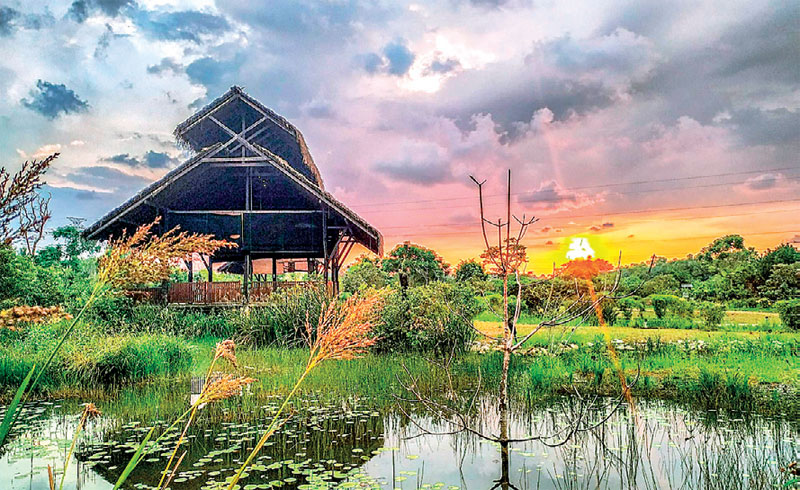Sunday Jan 11, 2026
Sunday Jan 11, 2026
Thursday, 30 December 2021 00:00 - - {{hitsCtrl.values.hits}}

With several lakes, waterways, marshes interspersed with small untouched patches of green, scrub vegetation and shady trees, the larger Kotte area is ideal for the purpose
 Diyasaru Park is the latest addition to the several recreational facilities developed around our parliamentary complex in Kotte. With several lakes, waterways, marshes interspersed with small untouched patches of green, scrub vegetation and shady trees, the larger Kotte area is ideal for the purpose. In the late afternoon hours, there are thousands of city residents enjoying the open environment; walking, jogging or merely taking in the fresh air.
Diyasaru Park is the latest addition to the several recreational facilities developed around our parliamentary complex in Kotte. With several lakes, waterways, marshes interspersed with small untouched patches of green, scrub vegetation and shady trees, the larger Kotte area is ideal for the purpose. In the late afternoon hours, there are thousands of city residents enjoying the open environment; walking, jogging or merely taking in the fresh air.
We have the popular Waters Edge complex, one-time golf course now converted to a crowded market place, function facility and popular walk. Such facilities are insufficient for a city of the size of Colombo; this place attracts so many that parking a vehicle at the Waters Edge carpark is an urban nightmare. In addition to these facilities, several well-designed walks have been developed nearby, along the longish Japan Sri Lanka Friendship Road and the Kimbulawela Walk which goes around a largish and lush paddy field.
It was while walking in the area that I noticed the Diyasaru Park, a 24-hectare preservation of urban wetland and wildlife. Although the complex is still being developed – I noticed several incomplete constructions, the park is appealing, the gravel path winding between beautiful trees and marsh, ending at a tall tower for birdwatching. The birdwatchers will not be disappointed; even my untrained eyes took in several birds. While walking along the path that quiet morning, I disturbed a couple of sun-bathing water monitors; hearing my footsteps they scampered into the water.
This is all in a small area of wetland, hemmed in by threatening urban developments on all sides. From the entrance, I took only 10 minutes to get to the end of the path, near the tower for birdwatching. In terms of what several other countries have showcased, ‘Diyasaru’ is a tiny preservation, its attractions notwithstanding. There is a levy to enter the park, Rs. 100 per adult. I think charging a levy is a good idea; these places need maintenance, and have to be valued even in a token manner. Being a government initiative, the park is bound to be overstaffed and poorly managed, a cost factor eventually.
However, I observed that the levy for a tourist was Rs. 500. A 10-minute walk, a few birds and a water monitor. This blatant overcharging from tourists is a matter that needs a national policy and an active input from the tourism authorities. It will not win favour with the tourists; not all of them are rich, and certainly is bad promotional policy. In any situation, discrimination leaves a bad impression; tourism is a service industry, winning friends and influencing others to come.
With my entrance ticket I was given a small brochure, which somewhat long-windedly announced that Diyasaru Park is a creation of two huge government organisations, Ministry of Megapolis and Western Development and Sri Lanka Land Reclamation and Development Corporation. The tone of the writing is hyperbolic, with little awareness of comparative parks in other countries; no heed to the park’s limitations, smallness or immaturities. An existence of its own, words robbed of reality.
To give you an idea of its character I will reproduce the opening paragraph of the leaflet –
“Extending about 24 hectares, Diyasaru Park is a dreamy opportunity for the visitors who need to get close to the nature forgetting about the heavy traffic jam, busy noises and ‘weltering’ heat in the busy city around them. Our vision is ‘to reduce the stress of urbanisation’…”
If the thought processes of our public servants are obscure, their written word is often bizarre! The impact of the brochure, on our presumably ‘urban stressed’ tourist from a metropolitan society, is open to imagination!
My favourite walk is around the Kimbulawela paddy field, taking about 30-40 minutes at a steady pace. The fresh air, the soothing green of the paddies, the gently flowing waters, are a much-needed tonic. I often wondered for how long this bit of pastoral serenity will remain untouched. Approximately about a year ago, part of the field was filled up, I saw some softball cricket being played there, even some youngsters flying kites. Sometimes, it was used as a car park.
This Sunday I was confronted by the ghastly sight of a high fence of corrugated sheets around this filled-up area. Most of the sheets were old and rusty. A closer inspection revealed that some kind of musical event or a carnival had been conducted within the enclosed space. The ground there was covered with waste; plastics, cans, masks, bottles all thrown about.
Even if an effort was made to remove the garbage, it is certain that some of it would escape into the surrounding waters and the fields. In fact, already the water around the polluted area looked dirty and discoloured.
A nature’s gift, violated.